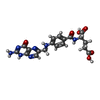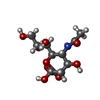+Search query
-Structure paper
| Title | Structures of MERS-CoV spike glycoprotein in complex with sialoside attachment receptors. |
|---|---|
| Journal, issue, pages | Nat Struct Mol Biol, Vol. 26, Issue 12, Page 1151-1157, Year 2019 |
| Publish date | Dec 2, 2019 |
 Authors Authors | Young-Jun Park / Alexandra C Walls / Zhaoqian Wang / Maximillian M Sauer / Wentao Li / M Alejandra Tortorici / Berend-Jan Bosch / Frank DiMaio / David Veesler /    |
| PubMed Abstract | The Middle East respiratory syndrome coronavirus (MERS-CoV) causes severe and often lethal respiratory illness in humans, and no vaccines or specific treatments are available. Infections are ...The Middle East respiratory syndrome coronavirus (MERS-CoV) causes severe and often lethal respiratory illness in humans, and no vaccines or specific treatments are available. Infections are initiated via binding of the MERS-CoV spike (S) glycoprotein to sialosides and dipeptidyl-peptidase 4 (the attachment and entry receptors, respectively). To understand MERS-CoV engagement of sialylated receptors, we determined the cryo-EM structures of S in complex with 5-N-acetyl neuraminic acid, 5-N-glycolyl neuraminic acid, sialyl-Lewis, α2,3-sialyl-N-acetyl-lactosamine and α2,6-sialyl-N-acetyl-lactosamine at 2.7-3.0 Å resolution. We show that recognition occurs via a conserved groove that is essential for MERS-CoV S-mediated attachment to sialosides and entry into human airway epithelial cells. Our data illuminate MERS-CoV S sialoside specificity and suggest that selectivity for α2,3-linked over α2,6-linked receptors results from enhanced interactions with the former class of oligosaccharides. This study provides a structural framework explaining MERS-CoV attachment to sialoside receptors and identifies a site of potential vulnerability to inhibitors of viral entry. |
 External links External links |  Nat Struct Mol Biol / Nat Struct Mol Biol /  PubMed:31792450 / PubMed:31792450 /  PubMed Central PubMed Central |
| Methods | EM (single particle) |
| Resolution | 2.5 - 3.0 Å |
| Structure data | EMDB-20542, PDB-6q04: EMDB-20543, PDB-6q05: EMDB-20544, PDB-6q06: EMDB-20545, PDB-6q07:  EMDB-20829: |
| Chemicals |  ChemComp-NAG:  ChemComp-FOL:  ChemComp-SIA:  ChemComp-HOH: |
| Source |
|
 Keywords Keywords |  VIRAL PROTEIN / VIRAL PROTEIN /  Coronavirus / Coronavirus /  spike glycoprotein / spike glycoprotein /  MERS-CoV / MERS-CoV /  membrane fusion / membrane fusion /  Structural Genomics / Seattle Structural Genomics Center for Infectious Disease / SSGCID Structural Genomics / Seattle Structural Genomics Center for Infectious Disease / SSGCID |
 Movie
Movie Controller
Controller Structure viewers
Structure viewers About Yorodumi Papers
About Yorodumi Papers












